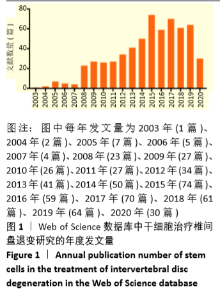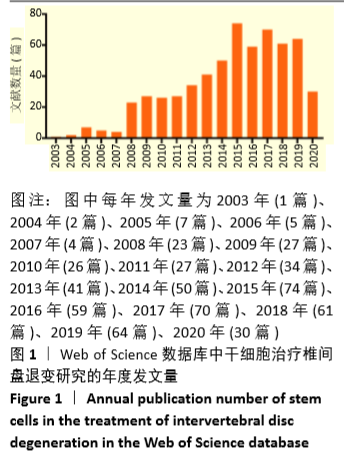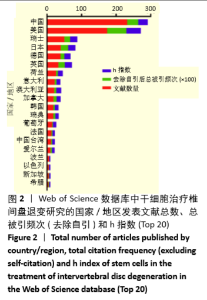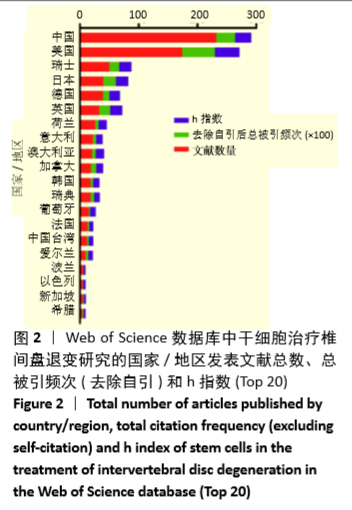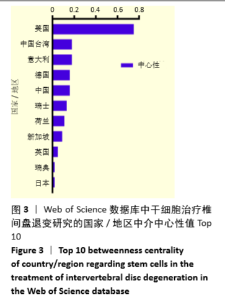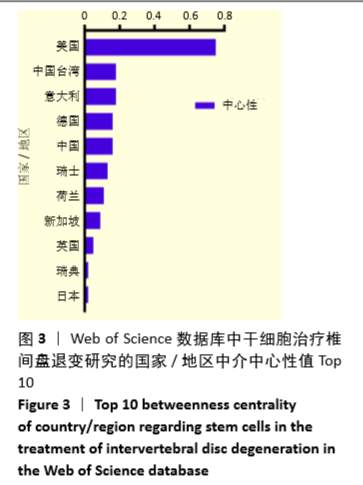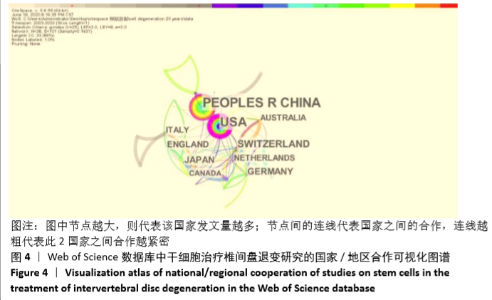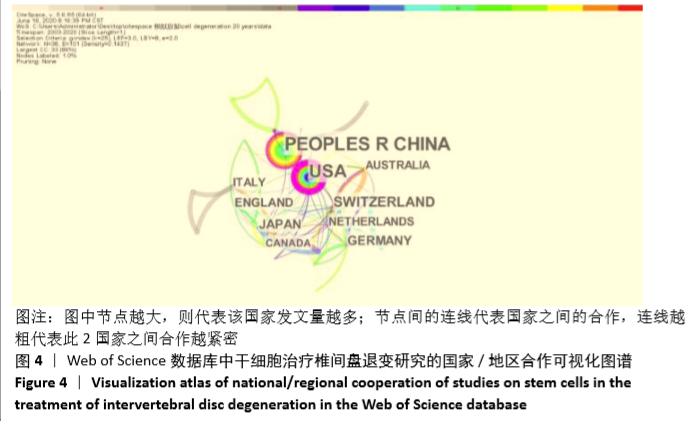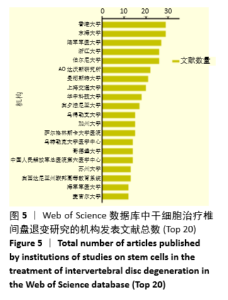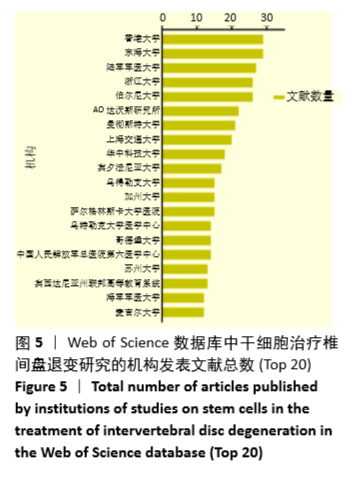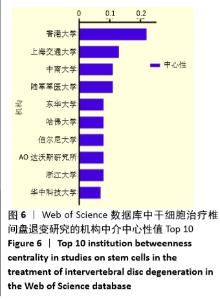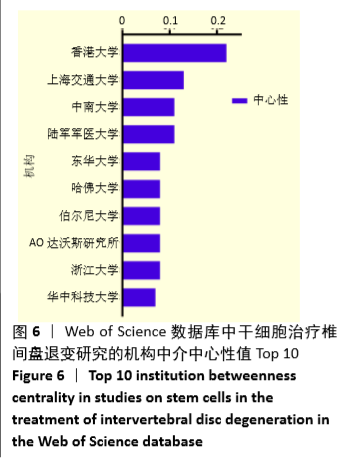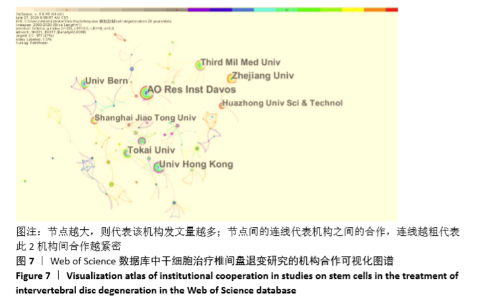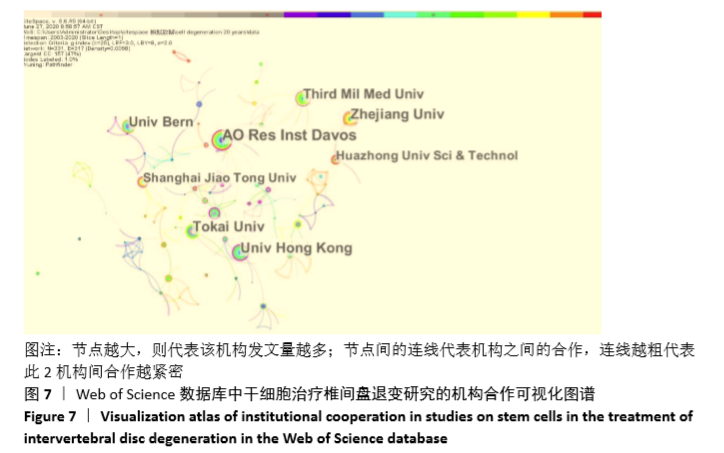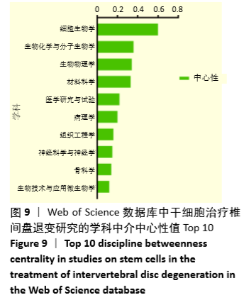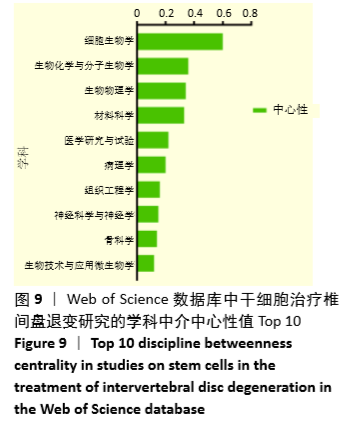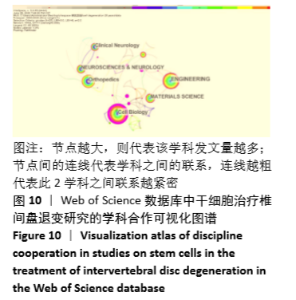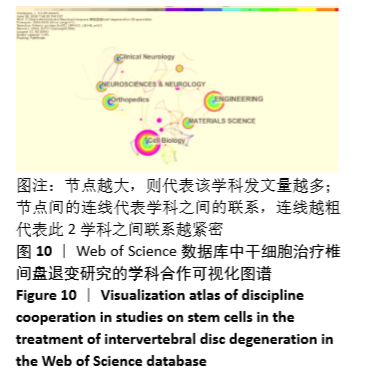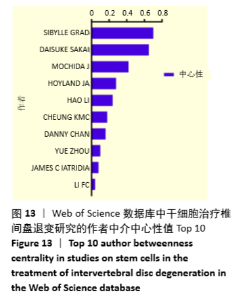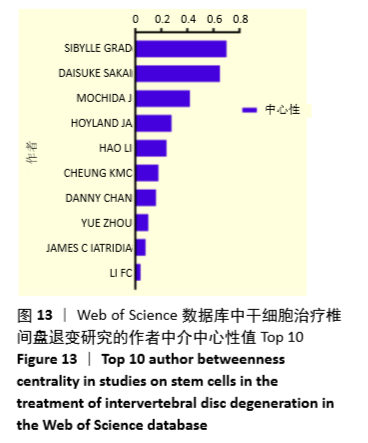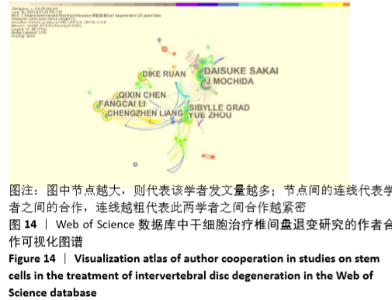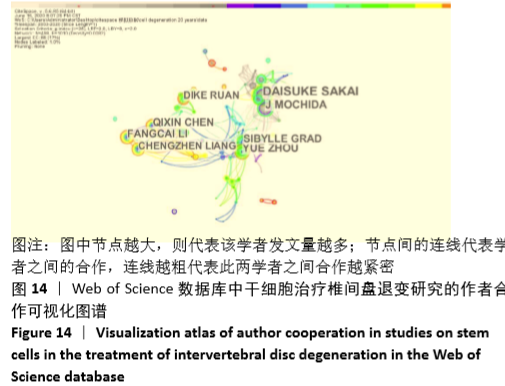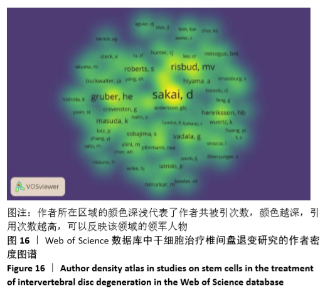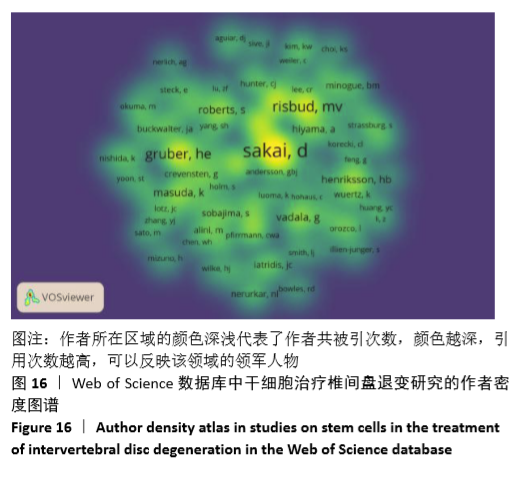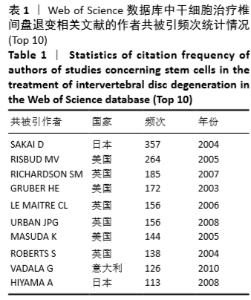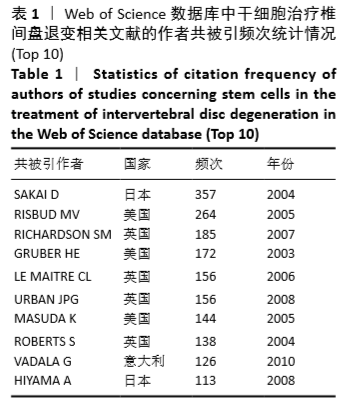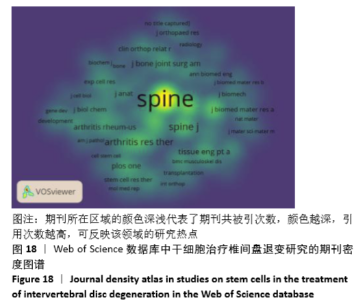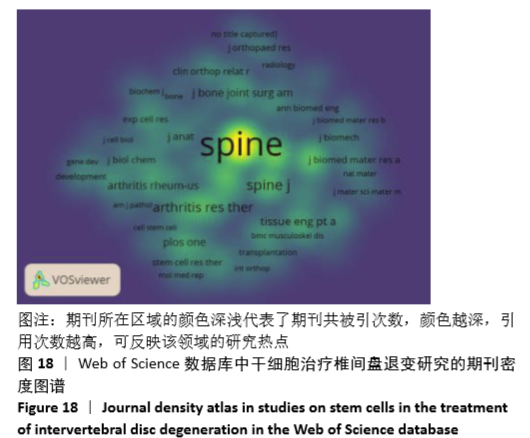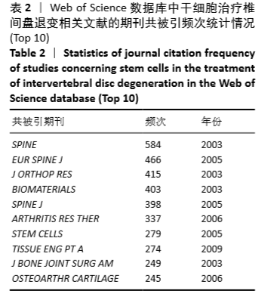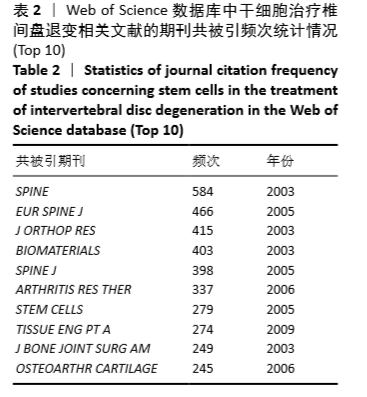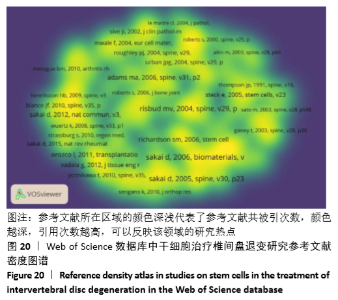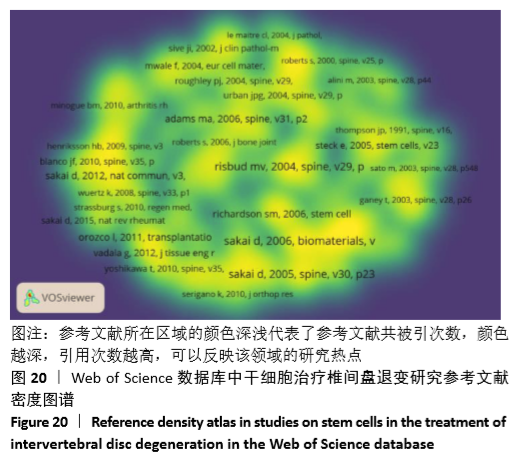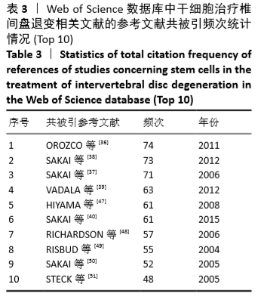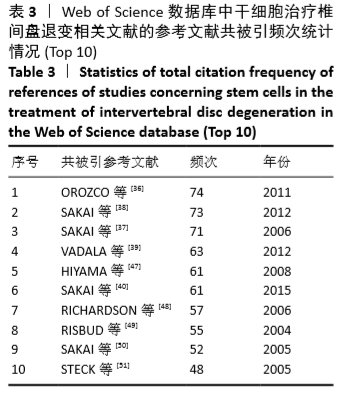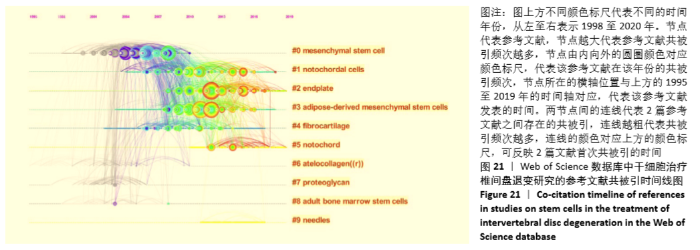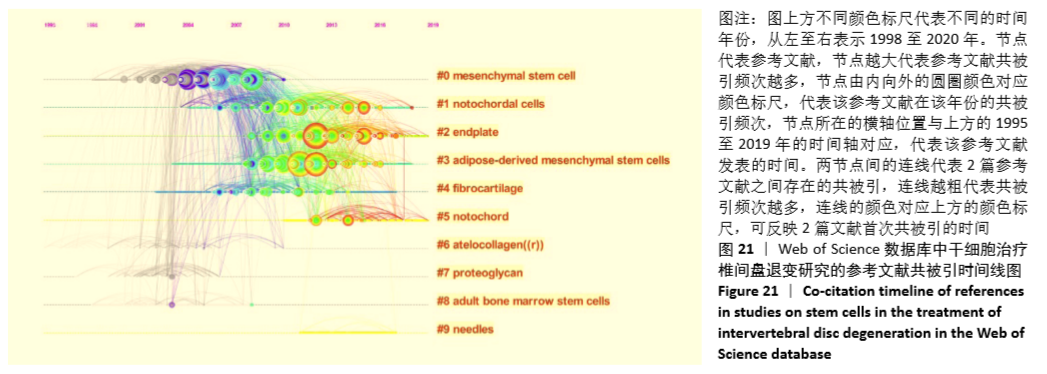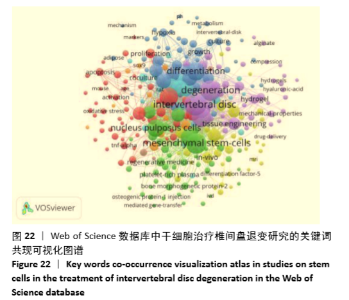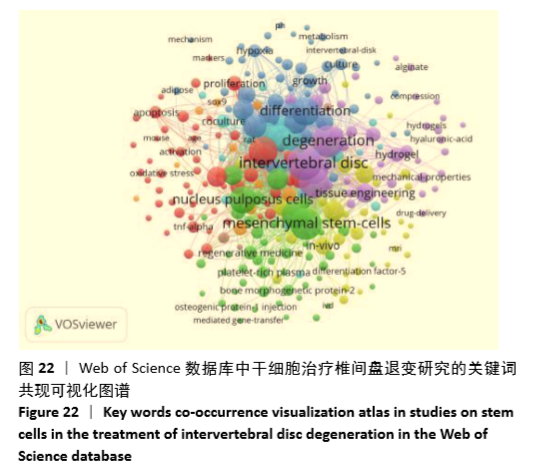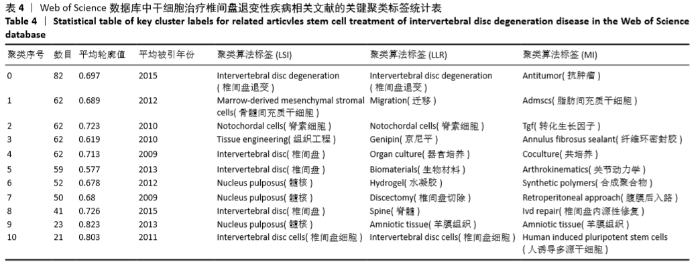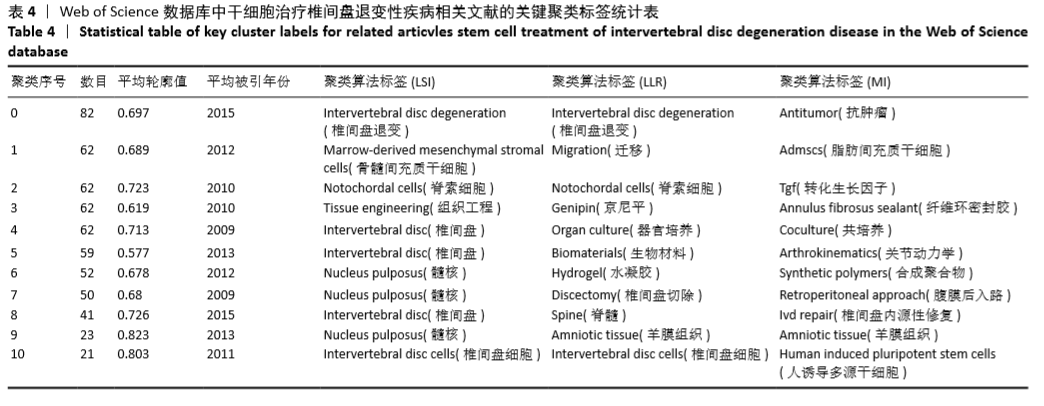Chinese Journal of Tissue Engineering Research ›› 2021, Vol. 25 ›› Issue (31): 5000-5011.doi: 10.12307/2021.143
Previous Articles Next Articles
Current states and tendency of stem cells in the treatment of intervertebral disc degeneration: bibliometric analysis
Li Qiujiang1, Fang Xiaomin1, 2, Wang Yinbin1, 2, Hu Xuehua2, Cai Lijun1, 2
- 1Third Clinical Medical College of Ningxia Medical University (People’s Hospital of Ningxia Hui Autonomous Region), Yinchuan 750002, Ningxia Hui Autonomous Region, China; 2The First Clinical Medical College of Northwest University for Nationalities (People’s Hospital of Ningxia Hui Autonomous Region), Lanzhou 730000, Gansu Province, China
-
Received:2020-07-13Revised:2020-07-14Accepted:2020-08-19Online:2021-11-08Published:2021-04-25 -
Contact:Cai Lijun, Associate professor, Chief physician, Master’s supervisor, Third Clinical Medical College of Ningxia Medical University (People’s Hospital of Ningxia Hui Autonomous Region), Yinchuan 750002, Ningxia Hui Autonomous Region, China; The First Clinical Medical College of Northwest University for Nationalities (People’s Hospital of Ningxia Hui Autonomous Region), Lanzhou 730000, Gansu Province, China -
About author:Li Qiujiang, Master candidate, Third Clinical Medical College of Ningxia Medical University (People’s Hospital of Ningxia Hui Autonomous Region), Yinchuan 750002, Ningxia Hui Autonomous Region, China -
Supported by:the Special Fund Project of Basic Scientific Research Business Expenses of Central Universities in 2017, No. 31920170183 (to CLJ)
CLC Number:
Cite this article
Li Qiujiang, Fang Xiaomin, Wang Yinbin, Hu Xuehua, Cai Lijun. Current states and tendency of stem cells in the treatment of intervertebral disc degeneration: bibliometric analysis[J]. Chinese Journal of Tissue Engineering Research, 2021, 25(31): 5000-5011.
share this article
Add to citation manager EndNote|Reference Manager|ProCite|BibTeX|RefWorks
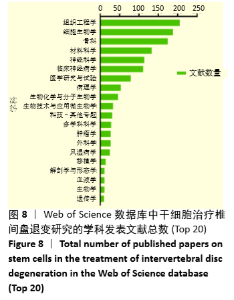
2.5 干细胞在椎间盘退变治疗研究中的学科分布 从总发文量上看,在干细胞治疗椎间盘退变性疾病研究方向主要为工程学(205篇),其次依次为细胞生物学(188篇)、骨科(174篇)、材料科学(133篇) 和临床神经病学(111篇)等方向,基本上偏向于基础研究方向,而相对外科手术学(27篇)方向的发文量甚少。从中心性指标来看,细胞生物学以中介中心性0.6系数值位列首位,其次依次为分子生物化学(0.36)、生物物理学(0.34)、材料科学(0.33) 和实验研究(0.22)等。同样从可视化图谱可见干细胞治疗椎间盘退变性疾病领域的研究方向主要以细胞生物学、组织工程学、骨科和材料科学为中心,相互交叉,相互联系,见图8-10。"
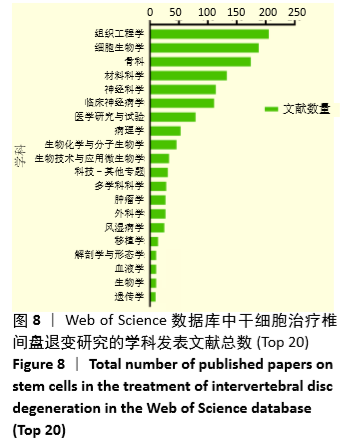
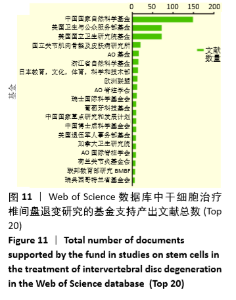
2.6 干细胞在椎间盘退变治疗研究中基金分布 文章通过对干细胞治疗椎间盘退变研究领域的基金支持情况进行分析,共列举了前20位基金项目,以中国国家自然科学基金项目支持的文献最多,共支持了149篇文献;项目“UNITED STATES DEPARTMENT OF HEALTH HUMAN SERVICES”和“NATIONAL INSTITUTES OF HEALTH NIH USA”均以72篇文献位列第2名;其中浙江省自然科学基金以支持15篇文献位列6名;此外“AO FOUNDATION”“AOSPINE”和“AO SPINE INTERNATIONAL”分别支持了16,11,9篇文献,均位于Top 20名次内, 见图11。"
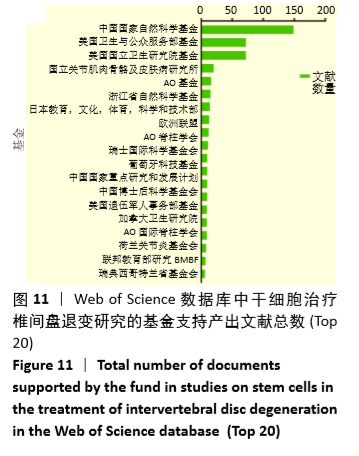
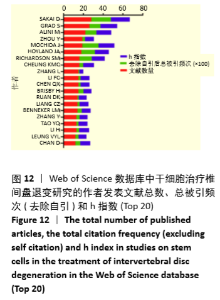
2.7 干细胞在椎间盘退变治疗研究中作者分析 从作者发文量方面看,以日本学者DAISUKE SAKAI学者28篇发文量位居首位,其次依次为爱尔兰学者SIBYLLE GRAD(26篇)、瑞士学者ALINI M(22篇)、日本学者MOCHIDA J(19篇)等,中国陆军军医大学周跃教授以19篇并列第4位;总体中国学者在该领域贡献巨大,Top 20中独占9席。从h指数方面比较,日本学者DAISUKE SAKAI以指数19位列首位,其次依次为爱尔兰学者SIBYLLE GRAD(17)、日本学者MOCHIDA J(16)、瑞士学者ALINI M(15)和英国学者HOYLAND JA(14)等,中国学者总体h指数均较低,位居后位。从总被引频次上看,分别为日本学者DAISUKE SAKAI(1 979次)、日本学者MOCHIDA J(1 632次)、英国学者HOYLAND JA(1 370次)、英国学者RICHARDSON SM(1 253次)、爱尔兰学者SIBYLLE GRAD(1 124次)、瑞士学者ALINI M(1 120次)。爱尔兰学者SIBYLLE GRAD学者中心性以0.71系数值显著高于其他作者,中国学者周跃、李方财作者中介中心性值分别为0.13和0.08。可视化图谱可见分别形成了以DAISUKE SAKAI国外学者为中心,以李方财及陈其昕浙江大学团队为中心,以陆军军医大学周跃教授为中心的合作网络,见图12-14。"
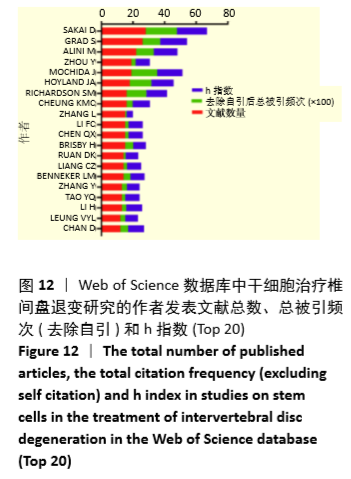
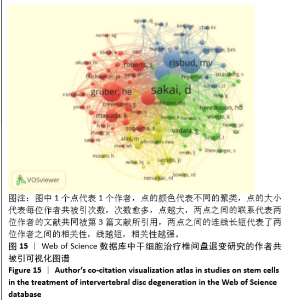
2.8.1 作者共被引分析 由于文章所纳入的引文文献数目较多,故将最低被引次数设定为55次,最终12 381作者中共有106篇文献纳入分析。通过VOSviewer对满足阈值106篇引文进行共被引强度以及相关性的分析和可视化图谱绘制。通过VOSviewer对参考文献进行聚类分析,共得到了4个聚类,分别用红、绿、蓝、黄4种颜色表示。红色显示第一聚类,共计37位作者,以GRUBER HE、MASUDA K和ROBERTS S学者为中心;绿色显示第2聚类,共计30位作者,以SAKAI D和VADALA G学者为中心;蓝色显示第3聚类,共计22位作者,以RISBUD MV学者为中心;黄色显示第4聚类,共计17篇文献,以ALINI M学者为中心,见图15,16。"
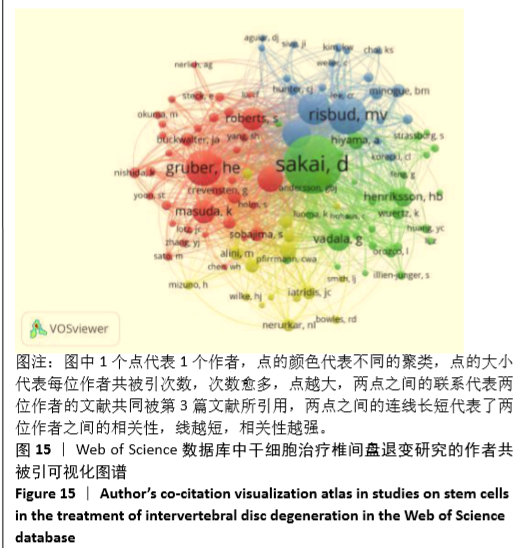
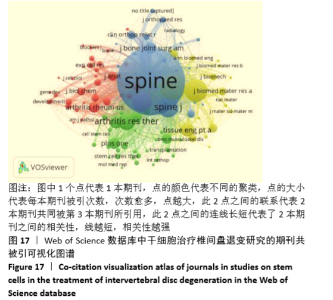
2.8.2 期刊共被引分析 由于文章所纳入的引文文献数目较多,故将最低被引次数设定为60次,最终2 772本期刊中共有111本期刊纳入分析。通过VOSviewer对满足阈值的111本期刊进行共被引强度以及相关性的分析和可视化图谱绘制。通过VOSviewer对期刊进行聚类分析,共得到了4个聚类,分别用红、绿、蓝、黄4种颜色表示。红色显示第1聚类,共计34本期刊,主要方向为椎间盘退变的细胞生物学研究;绿色显示第2聚类,共计31本期刊,主要方向为椎间盘退变的细胞疗法;蓝色显示第3聚类,共计25本期刊,主要方向为椎间盘退行性改变相关的临床试验;黄色显示第4聚类,共计20本期刊,主要研究为生物材料在椎间盘修复中的应用,见图17,18。"
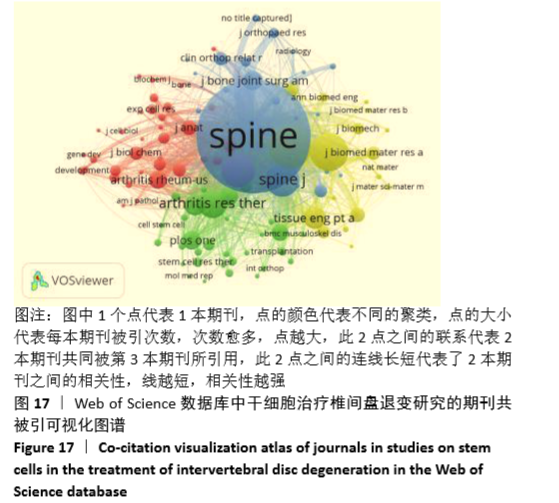
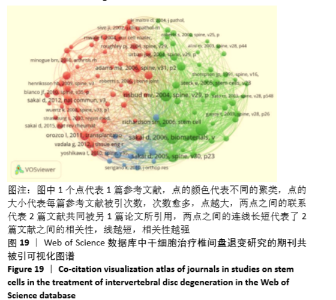
2.8.3 参考文献共被引 由于文章所纳入的引文文献数目较多,故将最低被引次数设定为40次,最终17 557被引文献中共有103篇文献纳入分析。通过VOSviewer软件对满足阈值103篇引文进行共被引强度以及相关性的分析和可视化图谱绘制。通过VOSviewer对参考文献进行聚类分析,共得到了3个聚类,分别用红、绿、蓝3种颜色表示。红色显示第1聚类,共计48篇文献,主要研究方向为生物材料的椎间盘修复治疗中的应用;绿色显示第2聚类,共计44篇文献,主要研究方向为间充质干细胞在椎间盘内的诱导分化研究;蓝色显示第3聚类,共计11篇文献,主要研究方向为种子细胞移植治疗椎间盘的相关试验研究,见图19,20。"
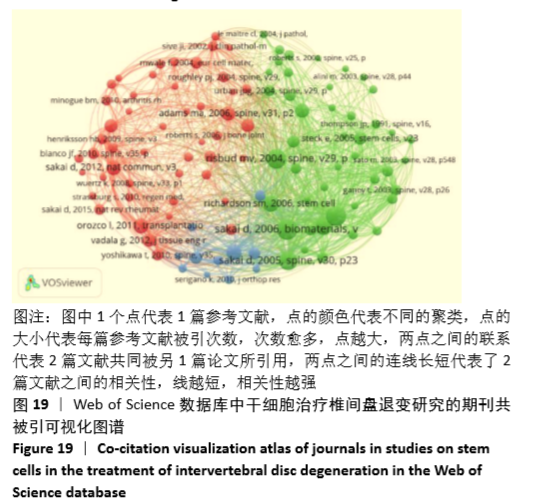
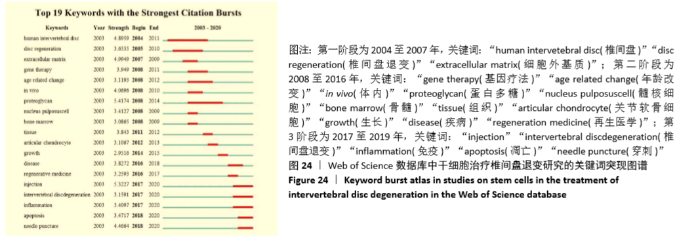
2.10 研究前沿及趋势在上述对关键词进行聚类分析的基础上,采用Citespace软件突现词功能对干细胞治疗椎间盘退变领域的前沿趋势进行探讨,并绘制突现词图谱,共得到19个突现关键词。右侧红色所占有的时间段即为该关键词持续时间。根据关键词突现强度和持续时间可以对该领域研究方向转变大致分为3个阶段:第1阶段为2004至2007年,主要研究集中在椎间盘发生退变后细胞外基质、蛋白多糖和相关基因表达的变化;第2阶段为2008至2016年,主要研究集中在将骨髓间充质干细胞、软骨终板干细胞等多种种子细胞采用细胞移植方法治疗椎间盘退变疾病;第3阶段从2017至2019年新出现的关键词有5个,分别是“injection”“intervertebral discdegeneration”“inflammation”“apoptosis”“needle puncture”,主要集中在细胞凋亡、炎性反应与椎间盘退变的联系以及细胞移植方法学等方面,见图24。"
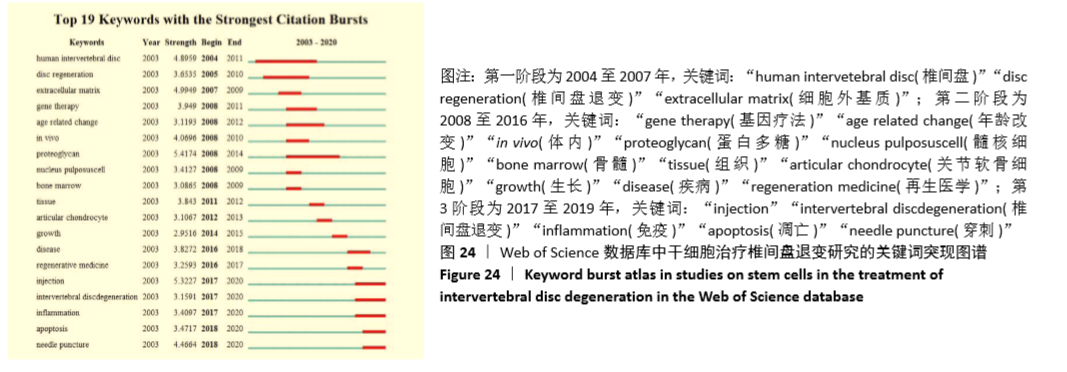
| [1] 王峣,徐志杰,李海昕,等.慢性腰痛生物学治疗的研究进展[J].中国骨与关节杂志, 2018,7(6):449-453. [2] BARAKAT AH, ELWELL VA, LAM KS. Stem cell therapy in discogenic back pain. J Spine Surg. 2019;5(4):561-583. [3] 余城墙,张宇,谢程欣,等.椎间盘退变分子生物学机制及再生治疗的优势与未来[J].中国组织工程研究,2019,23(30):4889-4896. [4] 王爽,俞磊,贺云飞,等.组织工程技术修复椎间盘纤维环的研究现状及应用前景[J].中国组织工程研究,2019,23(26):4255-4259. [5] BEALL DP, WILSON GL, BISHOP R, et al. VAST clinical trial: safely supplementing tissue lost to degenerative disc diseas. Int J Spine Surg. 2020;14(2):239-253. [6] URITS I, CAPUCO A, SHARMA M, et al. Stem cell therapies for treatment of discogenic low back pain: a comprehensive review. Curr Pain Headache Rep. 2019;23(9):65. [7] SILVA MJ, HOLGUIN N. Aging aggravates intervertebral disc degeneration by regulating transcription factors toward chondrogenesis. Faseb J. 2020;34(2):1970-1982. [8] CHEN X, ZHU L, WU G, et al. A comparison between nucleus pulposus-derived stem cell transplantation and nucleus pulposus cell transplantation for the treatment of intervertebral disc degeneration in a rabbit model. Int J Surg. 2016;28:77-82. [9] 王彦超,席志鹏,谢林.细胞疗法是修复退变椎间盘最有前景的技术[J].中国组织工程研究,2017,21(20):3234-3240. [10] 陈悦,陈超美,刘则渊,等. CiteSpace知识图谱的方法论功能[J].科学学研究,2015, 33(2):242-253. [11] 应倩,汪媛.医学类期刊H指数与影响因子、总被引频次的曲线拟合回归分析[J].中华医学图书情报杂志,2011,20(11):23-26. [12] HIRSCH JE. An index to quantify an individual’s scientific research output that takes into account the effect of multiple coauthorship. Scientometrics. 2010;85(3):741-754. [13] CHEN C, HU Z, LIU S, et al. Emerging trends in regenerative medicine: a scientometric analysis in CiteSpace. Expert Opin Biol Ther. 2012;12(5):593-608. [14] CHEN C, DUBIN R, KIM MC. Emerging trends and new developments in regenerative medicine: a scientometric update (2000-2014). Expert Opin Biol Ther. 2014;14(9):1295-317. [15] SAKAI D, MOCHIDA J, YAMAMOTO Y, et al. Transplantation of mesenchymal stem cells embedded in Atelocollagen gel to the intervertebral disc: a potential therapeutic model for disc degeneration. Biomaterials. 2003;24(20):3531-3541. [16] FENG JT, YANG XG, WANG F, et al. Efficacy and safety of bone substitutes in lumbar spinal fusion: a systematic review and network meta-analysis of randomized controlled trials. Eur Spine J. 2020;29(6):1261-1276. [17] CHEUNG J, KAO P, SHAM P, et al. Etiology of developmental spinal stenosis: a genome-wide association study. J Orthop Res. 2018; 36(4):1262-1268. [18] LIN Z, ZHAO Y, CHU PK, et al. A functionalized TiO2/Mg2TiO4 nano-layer on biodegradable magnesium implant enables superior bone-implant integration and bacterial disinfection. Biomaterials. 2019;219:119372. [19] XIA K, GONG Z, ZHU J, et al. Differentiation of pluripotent stem cells into nucleus pulposus progenitor cells for intervertebral disc regeneration. Curr Stem Cell Res Ther. 2019;14(1):57-64. [20] XIA K, ZHU J, HUA J, et al. Intradiscal injection of induced pluripotent stem cell-derived nucleus pulposus-like cell-seeded polymeric microspheres promotes rat disc regeneration. Stem Cells Int. 2019;2019:6806540. [21] ZHU J, YU W, WANG Y, et al. lncRNAs: function and mechanism in cartilage development, degeneration, and regeneration. Stem Cell Res Ther. 2019;10(1):344. [22] WANG C, GONG Z, HUANG X, et al. An injectable heparin-Laponite hydrogel bridge FGF4 for spinal cord injury by stabilizing microtubule and improving mitochondrial function. Theranostics. 2019;9(23):7016-7032. [23] ZUO R, LIU M, WANG Y, et al. BM-MSC-derived exosomes alleviate radiation-induced bone loss by restoring the function of recipient BM-MSCs and activating Wnt/beta-catenin signaling. Stem Cell Res Ther. 2019;10(1):30. [24] SAITO S, KUWASHIMA N, KOIZUMI H, et al. In vivo function of homing receptors participating in lymphocyte recirculation: transfer analysis in SCID mice. Pathobiology. 1995;63(6):305-313. [25] PEREIRA CL, GONCALVES RM, PEROGLIO M, et al. The effect of hyaluronan-based delivery of stromal cell-derived factor-1 on the recruitment of MSCs in degenerating intervertebral discs. Biomaterials. 2014; 35(28):8144-8153. [26] JIN W, LIANG X, BROOKS A, et al. Modelling of the SDF-1/CXCR4 regulated in vivo homing of therapeutic mesenchymal stem/stromal cells in mice. Peer J. 2018;6:e6072. [27] LIU J, PAN G, LIANG T, et al. HGF/c-Met signaling mediated mesenchymal stem cell-induced liver recovery in intestinal ischemia reperfusion model. Int J Med Sci. 2014;11(6): 626-633. [28] MENG X, CHEN M, SU W, et al. The differentiation of mesenchymal stem cells to vascular cells regulated by the HMGB1/RAGE axis: its application in cell therapy for transplant arteriosclerosis. Stem Cell Res Ther. 2018;9(1):85. [29] SAGGESE T, THAMBYAH A, WADE K, et al. Differential response of bovine mature nucleus pulposus and notochordal cells to hydrostatic pressure and glucose restriction. Cartilage. 2020;11(2):221-233. [30] 李德芳,江增鑫,曾庆敏,等.猪髓核基质成分诱导骨髓间充质干细胞分化为脊索样细胞[J].中国组织工程研究,2019,23(33):5366-5371. [31] 王刚,亢婷,刘毅,等.京尼平交联Ⅰ型胶原蛋白材料与人脂肪间充质干细胞的生物相容性[J].中国组织工程研究,2014,18(34): 5423-5428. [32] CHIONO V, PULIERI E, VOZZI G, et al. Genipin-crosslinked chitosan/gelatin blends for biomedical applications. J Mater Sci Mater Med. 2008;19(2):889-898. [33] FRAUCHIGER DA, MAY RD, BAKIRCI E, et al. Genipin-enhanced fibrin hydrogel and novel silk for intervertebral disc repair in a loaded bovine organ culture model. J Funct Biomater. 2018;9(3):40. [34] 杨文龙,张思泉,张国中,等.京尼平交联脱细胞气管支架种植自体骨髓间充质干细胞的体内原位移植研究[J].国际生物医学工程杂志,2019,42(5):375-382. [35] PENG Y, HUANG D, LI J, et al. Genipin-crosslinked decellularized annulus fibrosus hydrogels induces tissue-specific differentiation of bone mesenchymal stem cells and intervertebral disc regeneration. J Tissue Eng Regen Med. 2020;14(3):497-509. [36] OROZCO L, SOLER R, MORERA C, et al. Intervertebral disc repair by autologous mesenchymal bone marrow cells: a pilot study. Transplantation. 2011;92(7):822-828. [37] SAKAI D, MOCHIDA J, IWASHINA T, et al. Regenerative effects of transplanting mesenchymal stem cells embedded in atelocollagen to the degenerated intervertebral disc. Biomaterials. 2006;27(3):335-345. [38] SAKAI D, NAKAMURA Y, NAKAI T, et al. Exhaustion of nucleus pulposus progenitor cells with ageing and degeneration of the intervertebral disc. Nat Commun. 2012;3: 1264. [39] VADALA G, SOWA G, HUBERT M, et al. Mesenchymal stem cells injection in degenerated intervertebral disc: cell leakage may induce osteophyte formation. J Tissue Eng Regen Med. 2012;6(5):348-355. [40] SAKAI D, ANDERSSON GB. Stem cell therapy for intervertebral disc regeneration: obstacles and solutions. Nat Rev Rheumatol. 2015;11(4): 243-256. [41] SERIGANO K, SAKAI D, HIYAMA A, et al. Effect of cell number on mesenchymal stem cell transplantation in a canine disc degeneration model. J Orthop Res. 2010;28(10):1267-1275. [42] TUAN RS. Gel and cells: a promising reparative strategy for degenerated intervertebral discs. Ebiomedicine. 2020;55:102756. [43] TSUJIMOTO T, SUDO H, TODOH M, et al. An acellular bioresorbable ultra-purified alginate gel promotes intervertebral disc repair: a preclinical proof-of-concept study. Ebiomedicine. 2018;37:521-534. [44] UKEBA D, SUDO H, TSUJIMOTO T, et al. Bone marrow mesenchymal stem cells combined with ultra-purified alginate gel as a regenerative therapeutic strategy after discectomy for degenerated intervertebral discs. Ebiomedicine. 2020;53:102698. [45] TSUJIMOTO T, SUDO H, TODOH M, et al. An acellular bioresorbable ultra-purified alginate gel promotes intervertebral disc repair: a preclinical proof-of-concept study. Ebiomedicine. 2018;37:521-534. [46] HUSSAIN I, SLOAN SR, WIPPLINGER C, et al. Mesenchymal stem cell-seeded high-density collagen gel for annular repair: 6-week results from in vivo sheep models. Neurosurgery. 2019;85(2):E350-E359. [47] HIYAMA A, MOCHIDA J, IWASHINA T, et al. Transplantation of mesenchymal stem cells in a canine disc degeneration model. J Orthop Res. 2008;26(5):589-600. [48] RICHARDSON SM, WALKER RV, PARKER S, et al. Intervertebral disc cell-mediated mesenchymal stem cell differentiation. Stem Cells. 2006;24(3):707-716. [49] RISBUD MV, ALBERT TJ, GUTTAPALLI A, et al. Differentiation of mesenchymal stem cells towards a nucleus pulposus-like phenotype in vitro: implications for cell-based transplantation therapy. Spine (Phila Pa 1976). 2004;29(23):2627-2632. [50] SAKAI D, MOCHIDA J, IWASHINA T, et al. Differentiation of mesenchymal stem cells transplanted to a rabbit degenerative disc model: potential and limitations for stem cell therapy in disc regeneration. Spine (Phila Pa 1976). 2005;30(21):2379-2387. [51] STECK E, BERTRAM H, ABEL R, et al. Induction of intervertebral disc-like cells from adult mesenchymal stem cells. Stem Cells. 2005; 23(3):403-411. [52] BOREM R, MADELINE A, BOWMAN M, et al. Differential effector response of amnion- and adipose-derived mesenchymal stem cells to inflammation; implications for intradiscal therapy. J Orthop Res. 2019;37(11):2445-2456. [53] 刘四海,周少怀,羊明智,等.炎症与椎间盘退行性变关系的研究进展[J].脊柱外科杂志,2020,18(2):140-144. [54] MA K, CHEN S, LI Z, et al. Mechanisms of endogenous repair failure during intervertebral disc degeneration. Osteoarthritis Cartilage. 2019;27(1):41-48. [55] XIA C, ZENG Z, FANG B, et al. Mesenchymal stem cell-derived exosomes ameliorate intervertebral disc degeneration via anti-oxidant and anti-inflammatory effects. Free Radic Biol Med. 2019;143:1-15. [56] LIU W, RONG Y, WANG J, et al. Exosome-shuttled miR-216a-5p from hypoxic preconditioned mesenchymal stem cells repair traumatic spinal cord injury by shifting microglial M1/M2 polarization. J Neuroinflammation. 2020;17(1):47. [57] ZHANG Y, WANG WT, GONG CR, et al. Combination of olfactory ensheathing cells and human umbilical cord mesenchymal stem cell-derived exosomes promotes sciatic nerve regeneration Neural Regen Res. 2020;15(10):1903-1911. [58] CHEN J, CHEN J, CHENG Y, et al. Mesenchymal stem cell-derived exosomes protect beta cells against hypoxia-induced apoptosis via miR-21 by alleviating ER stress and inhibiting p38 MAPK phosphorylation. Stem Cell Res Ther. 2020;11(1):97. [59] JIANG W, ZHANG X, HAO J, et al. SIRT1 protects against apoptosis by promoting autophagy in degenerative human disc nucleus pulposus cells. Sci Rep. 2014;4:7456. [60] MIYAZAKI S, KAKUTANI K, YURUBE T, et al. Recombinant human SIRT1 protects against nutrient deprivation-induced mitochondrial apoptosis through autophagy induction in human intervertebral disc nucleus pulposus cells. Arthritis Res Ther. 2015;17:253. |
| [1] | Weng Rui, Lin Dongxin, Guo Haiwei, Zhang Wensheng, Song Yuke, Lin Hongheng, Li Wenchao, Ye Linqiang. Abnormal types of intervertebral disc structure and related mechanical loading with biomechanical factors [J]. Chinese Journal of Tissue Engineering Research, 2024, 28(9): 1436-1442. |
| [2] | Yang Yifeng, Ye Nan, Wang Lin, Guo Shuaicheng, Huang Jian. Signaling pathway of dexmedetomidine against ischemia-reperfusion injury [J]. Chinese Journal of Tissue Engineering Research, 2024, 28(9): 1464-1469. |
| [3] | Wang Weiqing, Zhou Yue. Chronic inflammation regulates adipose tissue fibrosis [J]. Chinese Journal of Tissue Engineering Research, 2024, 28(8): 1307-1312. |
| [4] | Mo Jun, Luo Zongping. Effects of static traction on the nucleus pulposus and annulus fibrosus of the rat intervertebral disc [J]. Chinese Journal of Tissue Engineering Research, 2024, 28(8): 1180-1185. |
| [5] | Yue Yun, Wang Peipei, Yuan Zhaohe, He Shengcun, Jia Xusheng, Liu Qian, Li Zhantao, Fu Huiling, Song Fei, Jia Menghui. Effects of croton cream on JNK/p38 MAPK signaling pathway and neuronal apoptosis in cerebral ischemia-reperfusion injury rats [J]. Chinese Journal of Tissue Engineering Research, 2024, 28(8): 1186-1192. |
| [6] | Wang Ji, Zhang Min, Li Wenbo, Yang Zhongya, Zhang Long. Effect of aerobic exercise on glycolipid metabolism, skeletal muscle inflammation and autophagy in type 2 diabetic rats [J]. Chinese Journal of Tissue Engineering Research, 2024, 28(8): 1200-1205. |
| [7] | Liu Xin, Hu Man, Zhao Wenjie, Zhang Yu, Meng Bo, Yang Sheng, Peng Qing, Zhang Liang, Wang Jingcheng. Cadmium promotes senescence of annulus fibrosus cells via activation of PI3K/Akt signaling pathway [J]. Chinese Journal of Tissue Engineering Research, 2024, 28(8): 1217-1222. |
| [8] | Xu Canli, He Wenxing, Wang Lei, Wu Fangting, Wang Jiahui, Duan Xuelin, Zhao Tiejian, Zhao Bin, Zheng Yang. Bibliometric analysis of researches on liver organoids [J]. Chinese Journal of Tissue Engineering Research, 2024, 28(7): 1099-1104. |
| [9] | Sun Yukang, Song Lijuan, Wen Chunli, Ding Zhibin, Tian Hao, Ma Dong, Ma Cungen, Zhai Xiaoyan. Visualization analysis of stem cell therapy for myocardial infarction based on Web of Science in recent ten years [J]. Chinese Journal of Tissue Engineering Research, 2024, 28(7): 1143-1148. |
| [10] | Mu Bingtao, Yu Jingwen, Liu Chunyun, Guo Minfang, Meng Tao, Yang Pengwei, Wei Wenyue, Song Lijuan, Yu Jiezhong, Ma Cungen. Immunomodulatory effect of astragaloside IV on T cells of experimental autoimmune encephalomyelitis mice [J]. Chinese Journal of Tissue Engineering Research, 2024, 28(7): 1057-1062. |
| [11] | Kang Zhijie, Cao Zhenhua, Xu Yangyang, Zhang Yunfeng, Jin Feng, Su Baoke, Wang Lidong, Tong Ling, Liu Qinghua, Fang Yuan, Sha Lirong, Liang Liang, Li Mengmeng, Du Yifei, Lin Lin, Wang Haiyan, Li Xiaohe, Li Zhijun. Finite element model establishment and stress analysis of lumbar-sacral intervertebral disc in ankylosing spondylitis [J]. Chinese Journal of Tissue Engineering Research, 2024, 28(6): 840-846. |
| [12] | Zhang Kefan, Shi Hui. Research status and application prospect of cytokine therapy for osteoarthritis [J]. Chinese Journal of Tissue Engineering Research, 2024, 28(6): 961-967. |
| [13] | Li Yangfeng, Tian Xin, He Fan, Yang Huilin. Melatonin-loaded gelatin methacryloyl microspheres delay nucleus pulposus degeneration [J]. Chinese Journal of Tissue Engineering Research, 2024, 28(5): 676-681. |
| [14] | Zhang Ya, Mu Qiuju, Wang Zilin, Liu Hongjie, Zhu Lili. Hydrogel loaded with platelet-rich plasma promotes wound healing in diabetic rats [J]. Chinese Journal of Tissue Engineering Research, 2024, 28(5): 690-696. |
| [15] | Tian Xin, Liu Tao, Yang Huilin, He Fan. In vitro evaluation of sustained release Kartogenin by gelatin methacryloyl microspheres for repairing nucleus pulposus degeneration [J]. Chinese Journal of Tissue Engineering Research, 2024, 28(5): 724-730. |
| Viewed | ||||||
|
Full text |
|
|||||
|
Abstract |
|
|||||
